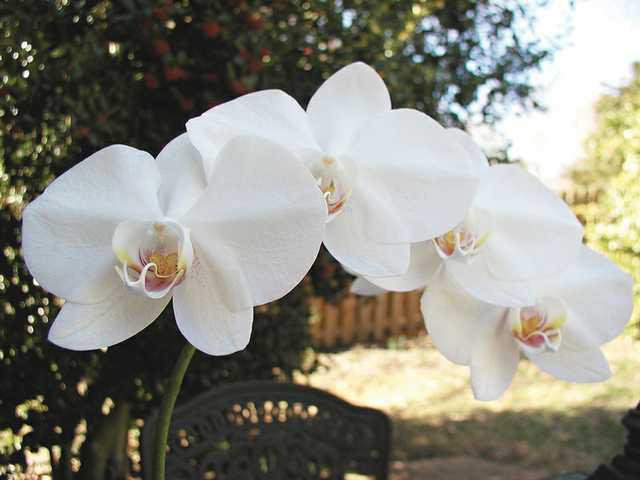Question: I recently purchased an orchid on impulse, but I know nothing about houseplants. Can you give me some advice on how to take care of it (the label says Phalaenopsis) and perhaps get it to bloom again next year?
Answer: You have asked the right person, because I also know very little about houseplants but I have managed to keep a couple orchids alive and blooming for a few years. Luckily, mine also are Phalaenopsis, supposedly the easiest to care for.
The Phalaenopsis orchid genus includes about 50 species from tropical Asia to Papua New Guinea and Australia. They sometimes go by the common name of moth orchid, supposedly because the blooms resemble a group of moths.
Plant breeders have produced literally thousands of hybrids from the original Phalaenopsis species. Most of the hybrids have blooms that are white, pink or some combination, often with spots or stripes as well.
These orchids are said to prefer temperatures of 55-65 degrees Fahrenheit at night and 65-80 F in the daytime, depending on the source of information. The cooler nighttime temperatures, especially in the fall, are said to help promote bud formation.
Recommended humidity is in the range of 50 percent to 80 percent, and they do not require a lot of light. These requirements seem achievable in the average home.
I keep one of my two orchids by a north-facing window where it gets no direct sunlight. I water it once a week by spraying both the leaves and the potting medium thoroughly with the vegetable sprayer at my kitchen sink or outside with a garden hose when the weather is warm.
My other orchid is by an east-facing window in the lower level of my house where it gets some direct morning sunlight. It has actually gotten too much sun at times and some of the leaves have turned yellow as a result.
This second orchid gets cooler temperatures year-round and I water it two or three times a week but seldom give it a thorough spraying. Probably because of the cooler temperature, it begins blooming about three weeks later than the one in my living room.
I keep my thermostat set at about 68 F when my furnace is operating and at about 78 F when the air conditioner is running. A hygrometer in the lower level of my house usually reads between 40 percent and 60 percent relative humidity.
Both orchids have been in their original potting mixtures about three years. I plan to re-pot them after they bloom this year, and the experts recommend re-potting every year or two.
After the blooms drop, you can often get a second bloom by cutting back the flower stem just above the node below where the first bloom appeared. If the plant does not re-bloom within a few months, next year’s bloom will probably arise from the top node of the old stem.
I have fertilized my orchids occasionally with a light feeding of liquid orchid fertilizer. Other than that, they get no special care.
While on the subject of orchids, I should mention the approximately 10,000 different ones on display at the Atlanta Botanical Garden. If you love orchids, and whether you want to raise them or not, a visit to the botanical garden at this time of year should delight you.
The garden has volunteers to answer your questions about orchid care and there are classes available for those who want to really get serious about raising orchids.
Russ England is a Master Gardener trained and certified in horticulture and related areas through by the Georgia Cooperative Extension.

